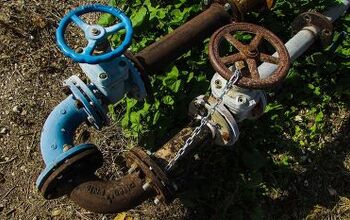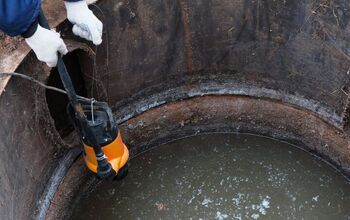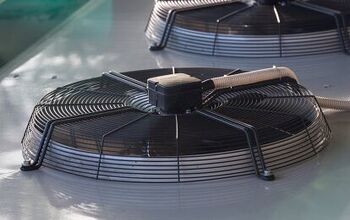Sump Pump Running Continuously? (Possible Causes & Fixes)

A sump pump that runs continuously is the most common reason for sump pumps overheating and breaking down. If you discover that your sump pump is always running, address the issue promptly. This will prevent further damage to the sump pump and your basement.
A sump pump that runs continuously is usually due to faulty float switches. If the switch becomes jammed or tangled, it can’t rise and fall, causing the pump to always run. The switch can also break while in the ON position, so the pump cannot stop running.
Do You Need Sump Pump Repair or Replacement?
Get free, zero-commitment quotes from pro contractors near you.

Reasons Why the Sump Pump Constantly Runs
A sump pump is the first line of defense for a homeowner if there is a basement flood. However, when the sump pump fails due to constant use, this can create far more significant problems than flooding. Before your system fails, figure out why your sump pump is continuously running.
Drainage and Plumbing Issues
Various plumbing issues can cause a sump pump to run continuously. A broken underground sprinkler system can provide a continuous supply of water to the sump pump causing it to overwork. Plumbing leaks or broken sewer pipes can also cause the sump pump to run constantly.
These issues can lead to more significant problems, such as foundation damage. If you suspect that this is the issue with your sump pump, contact a professional right away.
The Liner Is Too Big or Too Small
Sometimes the sump pump system isn’t big enough to handle the task, so it runs continuously or for short cycles. The sump pump can have enough power, but the pit is too small. This inadequate size causes the pump to fill up too fast and work overtime.
Broken Check Valve
The sump pump collects water that would flood the basement and pump it into a discharge line. The discharge line then directs the water out of the house running five to eight feet upward. A check valve prevents the water from flowing back into the pump.
If the check valve fails, the pump could be pumping the same water out repeatedly. This will overwhelm the pump and cause it to run continuously.
Flooding Sump Pit
Sometimes, there is a continuous flow of water into the sump pit from an underground spring or high water. While this is rare, it can happen, causing the sump pit to flood. Raising the sump pit, upgrading the system, or adding another sump pump can help.
The Home Is Built In The Wrong Place
In rare cases, a home may be just above a water table line. When the water table rises due to heavy rains, the sump pump will have to work against it. This can cause the sump pump to work continuously.
Float Switch Is Malfunctioning
A faulty float switch is one of the most common reasons for a continually running sump pump. When you install a sump pump on the basement floor, it includes a float switch. The float switch floats when the water rises in the sump pit.
When the switch floats up to a certain level, it triggers a switch to turn on the pump. Conversely, when the water lowers, the float switch lowers and turns the switch off. These switches can fail for two reasons, a jammed float switch or it is wandering.
The float switch can become jammed by debris and stuck on things in the pit like a wire or pipe. The sump pump can wander in the pit when it vibrates during operation. Both of these reasons can force the float switch into the ON position, causing the pump to run nonstop.
How to Fix a Malfunctioning Float Switch
To fix the sump pump float switch, follow the steps below.
Step 1: Open the Sump Pump
Open up the sump pump so that you can view the inside.
Step 2: Examine the Float Switch
Examine the float switch to determine if it is tangled or pinned against the liner. Be sure that it can move up and down with the water level. If it is stuck and cannot move freely, untangle the switch so that it can function correctly.
If the float switch can move with the waterline, it is most likely broken, and you should replace it.
Step 3: Purchase a Replacement Float Switch
If you need to replace the float switch, you can purchase one at most home improvement stores or online. Replacement switches typically range from $35 to $70.
Step 4: Remove the Old Float Switch
Remove the old float switch by simply unplugging it.
Step 5: Connect the New Float Switch
Connect the new float switch by plugging it into the same connection as the old one.
Step 6: Tether the Float Switch
Tether the float switch to a stationary object, like the sump pump itself. This will ensure that the switch can float up and down with the water levels. You can use a plastic zip tie or other durable material that won’t rot in the water.
Other Common Sump Pump Issues
As with any mechanical object, over time, the sump pump will have issues.
Overwhelmed Sump Pump
When a single sump pump can’t handle a flooded basement, the pump can become overwhelmed. This can happen for several reasons, such as not being reliable or powerful enough. For example, plastic models are often cheaper and more likely to fail, especially in the event of a flood.
To prevent this, you need to choose a sump pump of high quality. Upgrade your sump pump and add a backup battery. In rare instances, you may need to install more than one sump pump in different corners of the basement.
Clogged Sump Pump
Over time, sump pumps can become clogged and dirty, which can cause them to slow down or give out completely. The pump can become clogged in a variety of ways.
The sump pit, where the sump pump sits, can become clogged with dirt and debris. The pump’s mechanical parts can also become blocked. In turn, the float switch can malfunction and become jammed due to the debris.
To prevent the sump pump from becoming clogged, have it inspected periodically. Always make sure that your sump pump is covered with an airtight lid to prevent debris. The lid is necessary for children and pets’ safety and ensures water doesn’t evaporate back into the basement.
Frozen Discharge Lines
The sump pump expels any water collected through the discharge lines. However, if the discharge lines become frozen, the sump pump can fail.
How to Thaw Frozen Discharge Lines
If your sump pump becomes frozen, follow the steps below to thaw these lines.
Tools You Will Need for the Job:
- Space Heater (possibly)
- Hairdryer
- ShopVac, or a bucket and cup
- Screwdriver or small wrench
- Large pot of hot water
Step 1: Turn Off Power to The Sump Pump
Disconnect power from the system by switching the pump off, unplugging it, or turning it off at the breaker box.
Step 2: Inspect the Outer Drain Line
Inspect the area outside of the house where the drain line empties for ice or snow. If either is blocking the end of the line, remove any visible obstructions. If you believe that the block could be at the end of the line, set up a space heater.
You may also use a hairdryer to blow hot air into the drain opening. If you believe that the blockage is further inside of the drain, proceed to the next steps.
Step 3: Empty Any Water From the Sump Pit
If there is any water left in the sump pump pit, empty it. You can do this by using a ShopVac or cup and bucket to remove the water.
Step 4: Detach the Drain Line
Using a screwdriver or small wrench, loosen and detach the drain line from the pump.
Step 5: Pour Hot Water Into the Drain Line
Take a large pot of very hot water and pour it into the sump pump’s drain line. If the water begins to back up into the sump pump pit, remove it as necessary. Continue putting hot water into the drain line until it is thawed and can drain freely.
You may have to repeat this process several times before you manage to thaw the ice completely.
Step 6: Reconnect the Discharge Lines to the Pump
Reconnect the discharge lines back to the sump pump and restore power.
Do You Need Sump Pump Repair or Replacement?
Get free, zero-commitment quotes from pro contractors near you.

Related Questions
What is the cost to replace a sump pump?
Sump pump installation can range from $490 to $1,170. The average homeowner spends around $1,000 for installation. However, if you already have a sump pump and pipework in place, it can cost about $500 to replace it.If you are familiar with plumbing, you may be able to complete the replacement yourself. If you go this route, you can expect to pay around $300 for the replacement materials. Keep in mind the type of pump, basement flooring, and your current drainage system will determine the final price.
What maintenance is required when you have a sump pump?
It is hard to detect a problem with your sump pump until it completely fails to operate. In most cases, by then, the damage is extreme. The sump pump should receive routine maintenance every three to four months and a comprehensive service annually to prevent this.The homeowner can complete the quarterly maintenance, such as unplugging the pump and emptying the basin. Likewise, the homeowner can also remove any debris and check that the float switch works appropriately. However, a professional should complete annual sump pump maintenance for a more comprehensive look at the system.

Stacy Randall is a wife, mother, and freelance writer from NOLA that has always had a love for DIY projects, home organization, and making spaces beautiful. Together with her husband, she has been spending the last several years lovingly renovating her grandparent's former home, making it their own and learning a lot about life along the way.
More by Stacy Randall



























